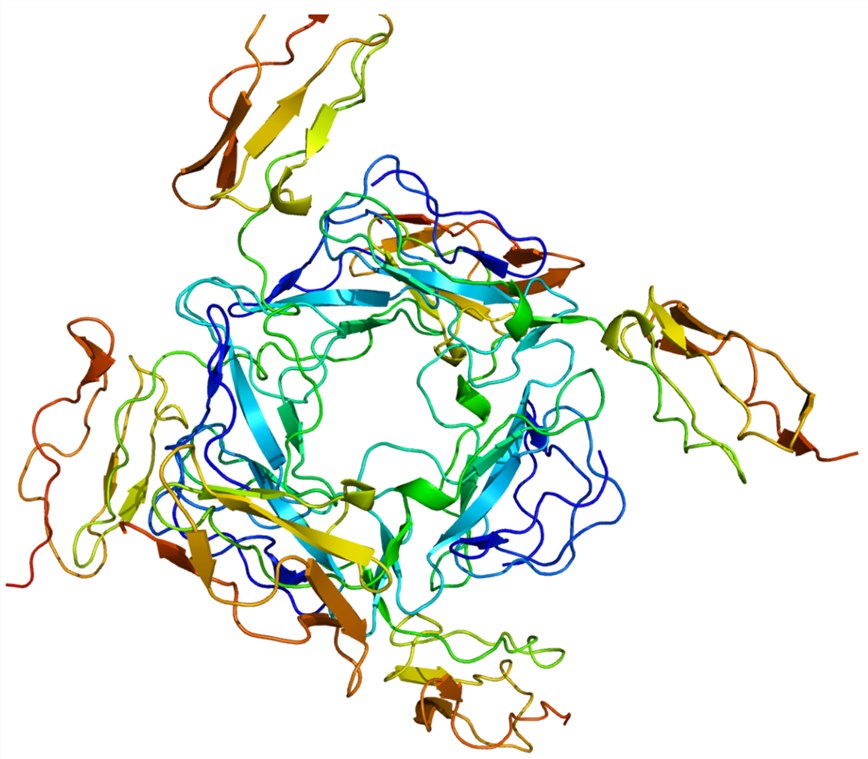Membrane cofactor protein (MCP/ CD46) is a widely distributed C3b /C4b-binding cell surface glycoprotein that acts as an inhibitor of host cell complement activation. MCP is a member of the family of regulators of complement activation (RCA) gene clusters. The common feature of this family is that it has about 60 amino acid repeat motifs, called short consensus repeats (SCR), and the family members are structurally, functionally and genetically highly correlated. MCP protein plays a role in regulating complement pathway and inflammation in immune complement-mediated syndromes. It not only has high research value in immunology, but also has potential for clinical application. Creative Biolabs offer powerful molecular tools such as monoclonal and polyclonal antibodies and molecular probes that can help researchers solve many biological problems related to MCP in these areas.

Fig. 1 Molecular structure of MCP.2
The Role of MCP in The Complement System
The alternative pathway (AP) continuously turns over, generating C3 fragments. If a C3b lands on host cells, it must be inactivated by regulatory proteins. MCP has been shown to have intrinsic regulatory activity, protecting cells that bind to it by inactivating C3b that binds to large protein complexes, including AP C5 convertase. Recent studies have shown that MCP is also an effective inhibitor of AP activation and feedback amplification loops, which plays a monitoring role in host cells. MCP may patrol the surface of host cells, looking for deposited C4b and C3b during inflammatory / immune responses or from spontaneous renewal of C4 and C3. In this regard, the MCP continuously monitors the cell surface to prevent the AP and its feedback loop from being occupied. This effect on complement proteins may only work if the AP feedback loop enables or expresses many MCPs. If C3b deposition requires AP or feedback loops, MCP is an effective inhibitor of the response.
In conclusion, the frequency of autoimmunity, especially systemic lupus erythematosus, in the absence of early complement components suggests a key role for regulatory proteins like MCP in maintaining the homeostasis of the immune system. Further experiments should focus on using physiological systems containing MCP as well as human autoantibodies and autoantigens to elucidate the role of C4b and C3b and their limited degradation products in normal and abnormal immune responses.
MCP and Pathogen Interactions
MCP is a receptor for many human pathogens. Its almost ubiquitous surface expression, its regulatory activity on the complement system, and its ability to signal cells make it a target for a variety of pathogens. The interaction between MCP and measles virus (MV) is a more thoroughly studied topic at present. Peptide map analysis, antibody blockade, substitution mutagenesis, and crystallographic studies provided information on the CD46 region, which revealed large non-glycan multi-contact binding sites spanning CCPs 1 and 2.
The binding of pathogens to CD46 has implications beyond cell adhesion. The combination of MV and CD46 resulted in a decrease in IL-12 production in human macrophages, an increase in nitric oxide production in mouse macrophages, and changes in the internalization pathway of non-lymphocyte line CD46. The interaction between Neisseria and CD46 produces calcium flux and tyrosine phosphorylation of CYT-2. After attachment of MV, Neisseria gonorrhoeae, herpesvirus 6 and rinderpest, CD46 on human cells is down-regulated. MV-induced down-regulation of CD46 results in increased complement sensitivity in infected cells. The large number of microorganisms using CD46 as a receptor and their multiple disease manifestations suggest the evolution of different strategies by which pathogens use their interactions with CD46.
Creative Biolabs offers high-quality MCP related services and products, including:
-
CD46 Antibodies
-
CD46 Related Proteins
-
CD46 Related Array Kits
-
CD46 Related Peptides
-
CD46 Related Lysates
Reference
-
From Wikipedia: By Emw - Own work, CC BY-SA 3.0 https://commons.wikimedia.org/wiki/File:Protein_CD46_PDB_1ckl.png
Related Product
For Research Use Only.
Related Sections:

